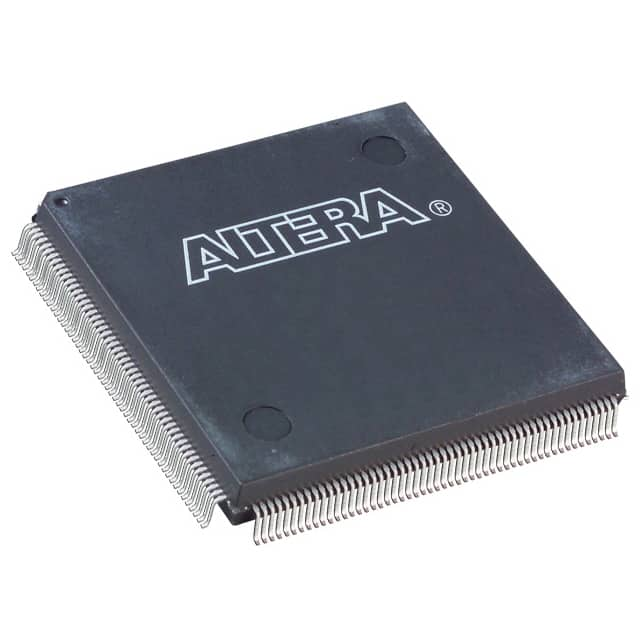Viz Specifikace pro podrobnosti o produktu.

EPF10K10AQC208-1
Product Overview
Category
The EPF10K10AQC208-1 belongs to the category of programmable logic devices (PLDs).
Use
This product is primarily used in digital circuit design and implementation. It provides a flexible and customizable solution for various applications.
Characteristics
- Programmable: The EPF10K10AQC208-1 can be programmed to perform specific functions based on the user's requirements.
- High Integration: It offers a high level of integration, combining multiple logic gates and flip-flops into a single device.
- Reconfigurable: The device can be reprogrammed multiple times, allowing for design changes or updates without replacing the hardware.
- Low Power Consumption: The EPF10K10AQC208-1 is designed to operate efficiently with low power consumption.
- Versatile: It supports a wide range of applications, making it suitable for diverse industries.
Package
The EPF10K10AQC208-1 is available in a Quad Flat Package (QFP) format.
Essence
The essence of this product lies in its ability to provide a flexible and customizable solution for digital circuit design and implementation.
Packaging/Quantity
The EPF10K10AQC208-1 is typically packaged individually and is available in varying quantities depending on the supplier.
Specifications
- Device Type: Programmable Logic Device (PLD)
- Family: EPF10K
- Series: 10K
- Package: QFP
- Number of Pins: 208
- Operating Temperature Range: -40°C to +85°C
- Supply Voltage: 3.3V
- Speed Grade: -1
Detailed Pin Configuration
The EPF10K10AQC208-1 has a total of 208 pins. The pin configuration is as follows:
(Pin Number) (Pin Name) 1. VCCIO 2. GND 3. IO0 4. IO1 5. IO2 6. IO3 7. IO4 8. IO5 9. IO6 10. IO7 11. IO8 12. IO9 13. IO10 14. IO11 15. IO12 16. IO13 17. IO14 18. IO15 19. IO16 20. IO17 ... 208. GND
Functional Features
- High-Speed Logic: The EPF10K10AQC208-1 operates at high clock frequencies, enabling rapid data processing.
- Flexible I/O Options: It offers a wide range of input/output options, allowing for seamless integration with other components.
- On-Chip Memory: The device includes on-chip memory elements, such as flip-flops and registers, to store and process data efficiently.
- Programmable Interconnects: The EPF10K10AQC208-1 provides programmable interconnects, enabling the user to establish custom connections between logic elements.
Advantages and Disadvantages
Advantages
- Flexibility: The EPF10K10AQC208-1 allows for easy customization and modification of digital circuits.
- Cost-Effective: It eliminates the need for multiple discrete components, reducing overall system costs.
- Time-Saving: The reprogrammable nature of this device saves time in design iterations and updates.
Disadvantages
- Learning Curve: Utilizing PLDs requires knowledge of hardware description languages and programming techniques.
- Limited Resources: The EPF10K10AQC208-1 has a finite number of logic elements and interconnects, which may restrict complex designs.
Working Principles
The EPF10K10AQC208-1 operates based on the principles of programmable logic. It consists of configurable logic blocks (CLBs), interconnects, and input/output elements. The CLBs contain look-up tables (LUTs) that can be programmed to implement specific logic functions. The interconnects allow for the routing of signals between different CLBs, enabling the creation of complex digital circuits. The input/output elements provide connectivity to external devices.
Detailed Application Field Plans
The EPF10K10AQC208-1 finds applications in various fields, including: 1. Industrial Automation: It can be used to control and monitor processes in manufacturing plants. 2. Communications: The device enables the implementation of communication protocols and signal processing algorithms. 3. Automotive Electronics: It can be utilized in automotive systems for functions like engine control, driver assistance, and infotainment. 4. Consumer Electronics: The EPF10K10AQC208-1 is suitable for designing custom logic circuits in consumer electronic devices.
Detailed and Complete Alternative Models
- EPF10K20AQC240-1: This model offers increased logic capacity and pin count compared to
Seznam 10 běžných otázek a odpovědí souvisejících s aplikací EPF10K10AQC208-1 v technických řešeních
Sure! Here are 10 common questions and answers related to the application of EPF10K10AQC208-1 in technical solutions:
1. What is EPF10K10AQC208-1? EPF10K10AQC208-1 is a specific model of Field Programmable Gate Array (FPGA) manufactured by Intel (formerly Altera). It is designed for various digital logic applications.
2. What are the key features of EPF10K10AQC208-1? Some key features of EPF10K10AQC208-1 include 10,000 logic elements, 208-pin Quad Flat Package (QFP), 5V operation, and 3.3V I/O compatibility.
3. What are the typical applications of EPF10K10AQC208-1? EPF10K10AQC208-1 can be used in a wide range of applications such as industrial automation, telecommunications, automotive electronics, medical devices, and consumer electronics.
4. How does EPF10K10AQC208-1 differ from other FPGAs? EPF10K10AQC208-1 offers a balance between cost, performance, and flexibility. It provides a good combination of logic elements, I/O pins, and package size, making it suitable for many general-purpose applications.
5. What programming languages can be used with EPF10K10AQC208-1? EPF10K10AQC208-1 can be programmed using Hardware Description Languages (HDLs) such as VHDL or Verilog. These languages allow designers to describe the desired functionality of the FPGA.
6. Can EPF10K10AQC208-1 be reprogrammed after deployment? Yes, EPF10K10AQC208-1 is a field-programmable device, which means it can be reprogrammed even after it has been deployed in a system. This flexibility is one of the advantages of using FPGAs.
7. What tools are available for programming EPF10K10AQC208-1? Intel provides Quartus Prime software, which is a comprehensive development environment for designing, simulating, and programming FPGAs. It supports EPF10K10AQC208-1 and other Intel FPGA devices.
8. Can EPF10K10AQC208-1 interface with other components or devices? Yes, EPF10K10AQC208-1 has a variety of I/O pins that can be used to interface with other components or devices such as sensors, actuators, memory modules, communication interfaces, and more.
9. What are the power requirements for EPF10K10AQC208-1? EPF10K10AQC208-1 operates at 5V, but it also supports 3.3V I/O compatibility. The power requirements may vary depending on the specific application and the overall system design.
10. Are there any limitations or considerations when using EPF10K10AQC208-1? Some considerations include the limited number of logic elements compared to higher-end FPGAs, the need for proper cooling and power management, and the requirement for expertise in FPGA programming and design.

